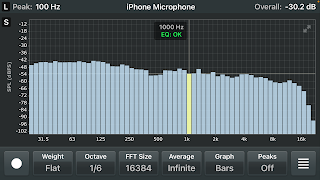The stereo was sounding great on Saturday night, and I was doing some rare serious listening. But in the morning the weird looking left channel response was bugging me, compared to the right. And it had been much better looking, so it seemed in the last post, just before I added the last 182 Hz boost. Then the lower midrange somehow got all messed up. I had to solve this riddle. And by Sunday afternoon my knees were no longer hurting from earlier days of adjusting (even using my 3" foam kneeling pad).
First I dialed out that boost at 182 Hz, which was seeming to be the culprit. But it wasn't. With no boost at 182 Hz it looked much worse overall, however the region 500-1000 Hz was perhaps slightly better, mysteriously. Very slightly. Not worth it. Only then I did a good re-measurement of the 182 Hz boosted version for comparison, and it was mysteriously looking quite a bit better than a few days ago just by chance (not EQ), and obviously better with the boost.
 |
| Left, 182 Hz Boost removed |
 |
| Left boost restored, "Janus 1.0", maybe not so bad |
I tried half as much boost. That was neither here nor there.
So then I just tried fixing the issues in the midrange while leaving the boost in place.
There was a depression centered around 400 Hz (it was a deep depression in the measurement I made a few days ago, today it was a fairly mild depression). And there was also a -3.5dB notch at 437 Hz. So I eliminated that notch, the the depression looked much better. I left another -2.5dB notch at 366 Hz untouched because 300 and 400 were about the same level with the 437 Hz cut removed.
Now that I'd given up the 437 Hz notch altogether, I had an available PEQ I could use for a notch at 833, which had been used in earlier smoother iterations, but (mistakenly it seems now) given up at one point as unnecessary. I might have intended to remove the 437 and ended up removing the 833 instead.
I moved the 903 Hz boost up to 1013 where it had been, but that left 900 depressed and added to the peak following 1khz. So I found a happy medium where 900 and 1000kHz are about the same, tuning the boost to 957 Hz. It's a very narrow boost so it doesn't raise the 800 Hz (I didn't change that). For the smoothest response above and below 1kHz I increased the boost from 4dB to 5dB which gave the flattest response around 1kHz.
With that, I needed to increase the depth of the notch at 654 Hz because that was bubbling up again. It had been precisely that I before but for some reason I'd then rolled it back.
And that was it, I got a smoothness from 500-2000 Hz which was similar if not better than the pre-182-Hz-boost response I'd measured a few days ago, but without sacrificing the 180-300 region which that boost fixed. Actually this is about the smoothest I recall ever seeing the Left Channel. Still not quite as smooth as the Right but pretty close. It's now good enough that I think I can relax on the EQ'ing for awhile.
 |
| Left Channel, "Janus 1.1" EQ |
 |
| Janus 1.1 PEQ's (only left panel changed) |
One notch was a restoration of a notch I had figured out by sweeping and was using earlier, the notch at 833 Hz. I basically just added that back and it helped so I'm thinking removing it was a mistake.
The boost was moved to a frequency based on the RTA effect and not sweeping this time. That was what I actually do a lot but not what I claim to be my method because it's leaving the ultimate hinge frequency to a wider than necessary analytical technique. But I've actually done that in many cases like this before. Sweeping the mids and highs is not easy at all because the distances from micro peaks to micro valleys (which you would see in a very slow sweep graph, it would be "thick" because of all the ups and downs) becomes a smaller and smaller portion of an octave, and the frequencies you can choose for the PEQ's get wider and wider and there's not much you can do to get really "in there." It is possible it might be better if I moved the boost a tick or two higher or lower based on sweeping or, gasp, sound. But it could not get any flatter RTA, since that was being optimized. I recall when I was sweeping that there was a dip at 903 Hz and also around 960 or so. When you get up to 1khz, it doesn't sound like it needs boosting at all. So the 957 may actually be just right and it's certainly pretty close to what I would have chose by sweeping.
No comments:
Post a Comment